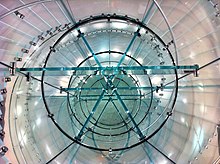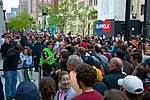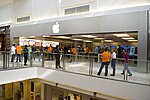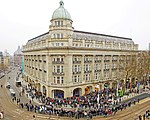Apple Store
![Entrance to Apple's subterranean flagship store on Fifth Avenue in Manhattan[1]](http://upload.wikimedia.org/wikipedia/commons/thumb/1/17/Apple_Store_Fifth_Avenue.jpg/200px-Apple_Store_Fifth_Avenue.jpg) | |
| Company type | Retail Workshop One to One |
|---|---|
| Industry | Subsidiary of Apple Inc. Computer hardware Computer software Consumer electronics Distribution |
| Founded | May 19, 2001 |
Number of locations | World: 400 stores in 14 countries United States: 250 United Kingdom: 35 Canada: 26 Australia: 18 France: 15 Italy: 12 Germany: 10 Spain: 10 China: 8 Japan: 7 Switzerland: 3 Hong Kong: 3 Sweden: 2 Netherlands: 1 |
Key people | Tim Cook (CEO) Steve Jobs (former CEO) Millard Drexler (director) |
| Products | Macs, OS X, iPads iPhones, iPods, Apple TV, Apple & 3rd-party software and accessories |
| Website | apple.com/retail |
The Apple Store is a chain of retail stores owned and operated by Apple Inc., dealing in computers and consumer electronics. The stores sell Macintosh personal computers, software, iPods, iPads, iPhones, third-party accessories, and other consumer electronics such as Apple TV. Some high profile stores feature a Theatre for presentations and workshops and a Studio for training with Apple products; all stores offer a Genius Bar for technical support and repairs, as well as free workshops available to the public. Under the leadership of Ron Johnson, the former Senior Vice President of Retail Operations, the Apple Stores have, according to an article in the New York Times, been responsible for "[turning] the boring computer sales floor into a sleek playroom filled with gadgets".[2]
As of August 2012[update], Apple has 395 stores worldwide, with global sales of US$16 billion in merchandise in 2011, and they lead the United States retail market in terms of sales per unit area.[3]
Description
Many stores are located inside shopping malls, but Apple has built several stand-alone "flagship" stores in high-profile locations. Flagship stores have opened in Amsterdam, Barcelona, Beijing, Boston, Chicago, Frankfurt, Hamburg, Hong Kong, Houston, London, Montreal, Munich, New York, Osaka, Paris, San Francisco, Shanghai, Sydney, Tokyo and Turin. The largest Apple Store in the world is in Amsterdam, on the Leidseplein.
Each store is designed to suit the needs of the location and regulatory authorities. Apple has received numerous architectural awards for its store designs, particularly its midtown Manhattan location on Fifth Avenue,[4][5] whose glass cube was designed by Bohlin Cywinski Jackson.[6]
Several flagship stores feature glass staircases,[7] which for multi-level stores was originally intended to attract customers to visit the upper floors, and some even feature a glass bridge. The New York Times wrote that these features were part of then-CEO Steve Jobs' extensive attention to detail. The first glass staircase received a design patent in 2002 from the U.S. Patent and Trademark Office with Jobs' name first, followed by several others,[8][9] while the staircase design itself received a design patent, and the complex glass and hardware system received a separate technical patent.[10] Apple worked with architect Bohlin Cywinski Jackson and engineer Eckersley O'Callaghan Structural Design in designing the staircase.[11][12]
The Apple Store in Regent Street, London, was the first to open in Europe in November 2004, and is the most profitable shop in London with the highest sales per square foot, taking £60,000,000 pa, or £2,000 per square foot.[13] The Regent Street store was surpassed in size by the nearby Apple Store in Covent Garden, which was surpassed in size by the Grand Central Terminal Store in December 2011.
Ron Johnson, Senior Vice President of Retail Operations until November 1, 2011, was responsible for site selection, in-store service, and store layout, however he had had no control over the inventory in the stores. Instead, inventory is done company wide by then-COO and now CEO Tim Cook who has a background in supply-chain management.[14][14]

Of the 43,000 Apple employees in the United States 30,000 work at Apple Stores. Due to the popularity of the brand applicants for jobs at Apple Stores are numerous with many young workers applying; pay is modest but generous benefits are offered. The pace of work is high due to the popularity of the iPhone and iPad. Employees typically work for only a few years as career prospects are limited with no path of advancement other than limited retail management slots.[3] Apple Store employees make above average pay for retail employees and are offered money toward college as well as gym memberships, 401k plans, healthcare plans, product discounts, and reduced price on purchase of stock. The retention rate for the technicians who man the Genius Bar is over 90%.[15]
History
Steve Jobs, the co-founder of Apple, returned as interim CEO in 1997. According to Jobs biographer Walter Isaacson, Jobs began a concerted campaign to help sales by improving the retail presentation of Macintosh computers. Even with new products launched under Job's watch like the iMac and the PowerBook G3 and an online store, Apple still relied heavily on big box computer and electronics stores for most of their sales. There, customers continued to deal with poorly trained and ill-maintained Mac sections that did not foster customer loyalty to Apple and did not help differentiate the Mac user-experience from Windows.[16]
Jobs' first push into retail upon returning to Apple was a study for stand alone "store within a store" for 34 sites in Japan. These sites were designed by Eight Inc. who was designing the Apple MacWorld and product launch events with Apple. This study became the validation for Apple’s retail market appeal and prototypes began for CompUSA which retained its Apple contract by agreeing to adopt Apple's "store within a store" concept designed by Eight Inc. This required that approximately 15% of each CompUSA store would be set aside for Mac hardware and software (including non-Apple products) and would play host to a part-time Apple salesperson. Jobs recognized the limitations of third party retailing and began investigating options to change the model. Tim Kobe of Eight Inc. prepared an “Apple Retail” white paper for Jobs outlining the virtues of separate Apple retail stores as a core touch point to directly drive the Apple brand experience based on their recently completed work with The North Face and Nike, other manufacturers, like Apple making the transition into independently controlled branded retail as part of their overall retail strategy.
Jobs knew the Apple retail program had to fundamentally change the relationship to the customer and provide more control over the presentation of Apple products and the Apple brand message. In 1999 Jobs retained Eight Inc. as the strategic retail design partner to begin creating the Apple retail store and began the search for senior retail and development executives.
In 1999, Jobs personally recruited Millard Drexler to serve on Apple's board of directors, Drexler was the CEO of Gap Inc. whose explosive growth had been attributed to retailing environments and marketing rather than its products or competitive prices. Drexler was one of the few directors who supported Jobs' retail stores initiative, the others on the board were skeptical as this would compete with third-party retailers, and also as Gateway, Inc. had struggled with its own stores. In 2000, Jobs hired Ron Johnson from Target, where he had been vice president of merchandising responsible for launching the Michael Graves line of consumer products[3] that raised Target's image beyond that of just an upscale K-Mart. At Drexler's suggestion, the retail team and development team headed by Allen Moyer, from The Walt Disney Company then began a series of mock-ups for the Apple store inside a warehouse near the company's headquarters in Cupertino.
On May 15, 2001, Jobs hosted a press event at Apple's first store at the Tysons Corner Center mall in Tysons Corner, Virginia. Jobs led a group of journalists from a hotel in Tysons Corner, Virginia, to Apple's first store in the second level of Tysons Corner Center for a commemorative press event.[17] The first two Apple Stores opened on May 19 in Tysons Corner and the same day in Glendale, California at Glendale Galleria.[18] The first Apple Store with the current layout and hardware (wood tables and stone flooring) opened in Pasadena, California.
The Apple retail program established its merits and the momentum provided by the introduction of the iPod drove enormous interest in the Apple brand. The “High Profile” retail stores began the initiation of the Flagship style component of the Apple retail strategy. The first high profile store was in Soho in New York City and was launched to great success. Store sales were double projections the first year with massive crowds and record sales. The iconic New York 5th Avenue store opened in 2002 became the punctuation to the world that Apple retail had arrived. The high profile retail stores, developed by Steve Jobs, the Apple retail team, designers Eight Inc., architects Bohlin Cywinski Jackson and structural engineers Eckerlsey O'Callaghan have become among the most recognized brand expressions in retail.
Economics of Apple Stores
Several publications and analysts predicted the failure of Apple Stores, based on sales made per square foot which was a standard metric in computer retail at the time. It was thought that because of the stores' diminutive size and non-aggressive sales team, Apple would succeed in presenting the Mac but fail in making a significant number of sales, despite the huge turnout for the Virginia store (7,700 in the first day purchases). However, Apple proved its critics wrong and by 2007 it ranked among the top retailers in the world. Apple opened its 200th store on October 26, 2007, in Gilbert, Arizona, 2,251 days after opening its Tysons Corner store.[19] According to Fortune; "and not just the architecture. Saks, whose flagship store is down the street, generates sales of $362 per square foot a year. Best Buy stores turn $930 - tops for electronics retailers - while Tiffany & Co. takes in $2,666. Audrey Hepburn liked Tiffany's for breakfast, but at $4,032 per square foot, Apple is eating everyone's lunch".[20] In 2011 Apple Stores in the United States had revenue of $473,000 for each employee.[3] According to the research firm RetailSails, the Apple Store chain ranks first among U.S. retailers in terms of sales per unit area in 2011, with sales of US$3,085 per square feet, almost doubling Tiffany & Co., the second retailer on the list.[3]
Apple has since re-established ties with major big box retailers like Best Buy, as these chains have considerably more geographical reach than the existing network of Apple Stores. The relationship with Best Buy calls for the company to send Apple Solutions Consultants (ASCs) to train Best Buy employees to be familiar with Apple's product lineup and how Macs work.[16][21]
Apple Stores have considerably changed the landscape for consumer electronics retailers and influenced other technological companies to follow suit. According to The Globe and Mail, "Apple’s retail stores have taken traffic, control and profits away from Verizon as well as electronics retailers, such as Best Buy, that once looked at wireless phones as a lucrative profit source". The Microsoft Store is similar to Apple's retail stores, by not only having sales staff but also employing "Technical Advisors" (similar to Apple's "Geniuses") to assist customers with technical questions and issues, plus Microsoft also trains staff from third party retailers at their Retail Experience Center.[22] There has been speculation that Nokia and Samsung have been considering their own chains of retail stores as well.[1][2]
Expansion and changes
Originally, Apple Stores contained a dedicated point-of-sale (POS) station. However, in 2006, Apple began introducing a new store layout and design with surgical-grade stainless steel walls and backlit signage. The new store design replaced the dedicated point-of-sale station with the handheld EasyPay system. A dedicated point-of-sale station still exists in most of these stores to facilitate transactions not paid for by credit card.[23][24] The Regent Street store has more point-of-sale terminals than any other store. Only flagship stores and a few older locations have a dedicated point of sale; all other stores have a POS behind the Genius Bar. Apple has recently changed their EasyPay systems to operate on iPod Touch instead of the previous Windows-based system. The iPods feature a custom housing, the Infinite Peripherals Linēa-Pro barcode scanner and card reader, to allow the same transactions on the iPod.[citation needed]
On May 22, 2011, Apple replaced their acrylic displays that had information about the product with interactive iPad 2 displays, which add more information about the product like information about the specifications, comparisons and extended warranties.[25] This transition from paper to touch displays was dubbed "Apple Store 2.0" by online blogs such as Engadget and Gizmodo.[26]
The successful experience that Apple had with its retail stores has been applied to Disney stores, since Jobs was elected to that company's board of directors in 2006.[27]
Genius Bar

All Apple Stores feature a Genius Bar, where customers can receive technical advice or set up service and repair for their products. The Genius Bar provides software support for Mac OS X and hardware service on products that are not classified vintage or obsolete.[28] However, in most cases the Geniuses will at least attempt to assist customers with older hardware.[29] Originally, visitors to the Genius Bar were offered free Evian water. Apple dropped this amenity in February 2002.[citation needed]
To address increasing numbers of iPod customers at the Genius Bar, some new stores also feature an iPod Bar. First seen at the Ginza store in Tokyo, then at the New York City locations, the iPod Bar has become a common feature at newly built stores.[30]
Most[citation needed] new stores feature a station called The Studio, a Genius Bar-like setting where customers can meet with a "Creative" and receive help with projects ranging from organizing a photo album to music composition to film editing.[citation needed] Some of the older stores are being considered to carry a Studio in a future remodel, in some cases replacing the older theaters.[citation needed]
Genius Training Manual
Every Apple Store employee is provided with a training manual that teaches him or her marketing and manipulation techniques. The basic tenet is that "Everyone in the Apple Store is in the business of selling".[31]
Store openings
Store openings have become special events among avid Macintosh users.[citation needed] Opening day attracts thousands of customers who line up early in the morning or even the night before.[citation needed] Most openings are accompanied by giveaways of prizes such as t-shirts and "lucky bags" at flagship store openings.[32][33]
-
A line at the opening of the first Apple Store, in Tysons Corner Center on May 19, 2001
-
A massive crowd gathered on the sidewalk of Boylston Street, Boston, MA for the opening of the new store on May 15, 2008
-
A man holding up his commemorative T-shirt given out at the Boylston Street Apple Store opening day
-
The London, England Apple Store on Regent Street at its opening at 10am 20 November 2004.
-
Apple Store in Sydney, New South Wales on George Street
-
Apple Store in Westfield Doncaster, Victoria, Australia
-
Apple Store in Covent Garden, London
-
Apple Store in Amsterdam, Netherlands
Locations
The first two Apple Stores opened in the United States in 2001 (see history above). In 2003, Apple expanded its operations into Japan, opening the first store outside of the United States. This was followed by the opening of stores in the United Kingdom, Canada, Italy, Australia, China (including Hong Kong), Switzerland, Germany, France, Spain, Netherlands and Sweden. In 2010 a major effort to expand sales in China was announced along with opening of a store in Shanghai. The first Apple Store in Hong Kong, being the 100th overseas store outside the United States opened on September 24, 2011, occupying Podium 1 and 2 of ifc mall.
| Location | First openings | Open stores | Reference |
|---|---|---|---|
| May 19, 2001 | 250 | [34] | |
| November 20, 2004 | 36 | [35] | |
| May 21, 2005 | 26 | [36][37] | |
| June 19, 2008 | 18 | [38] | |
| November 7, 2009 | 15 | [39] | |
| March 31, 2007 | 12 | [40] | |
| December 6, 2008 | 10 | [41] | |
| September 4, 2010 | 10 | [42] | |
| June 19, 2008 | 8 | [43] | |
| November 30, 2003 | 7 | [44] | |
| September 25, 2008 | 3 | [45][46] | |
| September 24, 2011 | 3 | [47] | |
| September 15, 2012 | 2 | [48] | |
| March 3, 2012 | 1 | [49] |
Apple Company Store
The Apple Company Store is found on the Apple Campus in One Infinite Loop. This store is the original Apple Employee store, and is open to the public. The store does not sell any of Apple's computer or iPod lineups, and it does not provide on-site support or repairs. However, it is the only place where Apple T-Shirts, hats, and other such merchandise can be purchased.[50] Apple products are on display here, and various software and accessories can be purchased as well.[51]
Imitations
In July 2011, an American expatriate blogger who lives in the southwestern Chinese city of Kunming reported on her discovery of what she called "the best ripoff store we had ever seen"—a fake Apple Store, complete with the glass exterior, wood display tables, winding staircase and large promotional posters found in legitimate Apple Stores, and with employees wearing lanyards and the same T-shirts as actual Apple Store employees.[52] The Wall Street Journal reported that the store had "gotten widespread international attention for the remarkable lengths to which its proprietors seem to have gone to mimic the look and feel of a real Apple Store."[53] Chinese law prohibits retailers from copying the look and feel of competitors' stores, but enforcement is lax.[54]
According to The Wall Street Journal, unauthorized Apple resellers are found throughout China; the blogger's original post noted that two such stores were located within walking distance of the first knockoff, one of them with a misspelled sign reading "Apple Stoer".[53] An employee of the first knockoff confirmed that the store was not one of the 13[54] authorized Apple resellers in Kunming.[52][53] In a follow-up report, Reuters indicated that local authorities in Kunming had closed two fake Apple stores in that city due to lack of official business permits, but allowed three other such stores to stay open, including the one that had attracted international attention.[54] The operators of that store had applied for a reseller license from Apple.[54] At the time of the report, only four legitimate Apple Stores had opened in China, with two in Beijing and two in Shanghai.[53]
Following these events, more real Apple Stores in China started opening up. For example, the Shenzhen Apple Store.
References
- ^ Apple Retail Store
- ^ Clifford, Stephanie; Helft, Miguel (June 14, 2011). "Ron Johnson, Apple Stores Chief, to Lead J.C. Penney". The New York Times.
- ^ a b c d e David Segal (June 23, 2012). "Apple's Retail Army, Long on Loyalty but Short on Pay". The New York Times. Retrieved June 23, 2012.
- ^ Lohr, Steve (2006-05-19). "Apple, a Success at Stores, Bets Big on Fifth Avenue". The New York Times. Retrieved 2006-05-19.
- ^ "Apple Computer Retail Stores: Gold, Environments". Industrial Designers Society of America. 2002. Archived from the original on 2006-02-14. Retrieved 2006-05-12.
- ^ Saffron, Inga (2011-03-06). "Bernard Cywinski, paterfamilias of Philadelphia architecture". The Philadelphia Inquirer. Retrieved 2011-04-02.[verification needed]
- ^ ifoAppleStore - List of Glass Staircase Stores
- ^ Helft, Miguel; Carter, Shan (August 25, 2011). "Apple Patents Show Steve Jobs's Attention to Design". The New York Times.
- ^ Carter, Shan (August 25, 2011). "Steve Jobs's Patents". The New York Times.
- ^ http://pdf.ifoman.com.s3.amazonaws.com/staircase_page_patent_c.pdf
- ^ ifo Apple Store - Glass Staircase
- ^ Eckersley O’Callaghan
- ^ "Apple Store London". macdailynews. 2010. Retrieved 2010-08-06.
- ^ a b Adam Lashinsky (August 25, 2011). "How Apple works: Inside the world's biggest startup". CNN.
- ^ "New York Times profiles Apple's retail operations and employees". 9 to 6 Mac. June 23, 2012. Retrieved June 24, 2012.
- ^ a b Best Buy and Apple Together Again - AppleMatters
- ^ Remembering Apple's First Store[dead link]
- ^ Timeline of Apple Stores.[dead link]
- ^ Apple nearing milestone opening
- ^ The Roots of Apple's Retail Stores
- ^ Apple throwing its weight into Best Buy Mac sales? | Ars Technica
- ^ Olivarez-Giles, Nathan (2010-11-26). "For some, the Microsoft Store concept is a puzzle". Los Angeles Times. Retrieved 2011-01-09.
- ^ "Store Redesign Photos". ifo Apple Store. 2006-09-22. Retrieved 2006-10-04.[dead link]
- ^ "Apple Store's Easy Pay". Adding Understanding blog. 2006. Retrieved 2006-10-04.
- ^ First look at 'Apple Store 2.0' in Australia[dead link]
- ^ Apple Store celebrates 10th anniversary with 2.0 experience, iPads locked in Lucite (video) - Engadget
- ^ NYT: Apple inspiring new Disney retail strategy | Macworld
- ^ "Vintage and obsolete products"
- ^ "Old School Genius". Tech Today. 2005. Archived from the original on 2006-10-15. Retrieved 2006-10-04.
- ^ "iPod Bar Japan: Great Service But The Cocktails Need Work". Gizmodo. 2005. Archived from the original on 12 September 2006. Retrieved 2006-10-04.
{{cite web}}: Unknown parameter|deadurl=ignored (|url-status=suggested) (help) - ^ Biddle, Sam. "How To Be a Genius: This Is Apple's Secret Employee Training Manual". Gizmodo.com. Retrieved 31 August 2012.
- ^ "Grand Opening Lucky Bags". ifo Apple Store. November 28, 2005. Archived from the original on 27 April 2006. Retrieved 2006-05-12.
{{cite web}}: Unknown parameter|deadurl=ignored (|url-status=suggested) (help) - ^ Preview: Inside Shanghai's first Apple Store - Shanghaiist
- ^ Apple Retail Store (United States) - Store List
- ^ Apple Retail Store (United Kingdom) - Store List
- ^ Apple Retail Store (Canada) - Store List
- ^ Apple Store (Canada) - Liste des boutiques Template:Fr
- ^ Apple Retail Store (Australia) - Store List
- ^ Apple Store (France) - Liste des magasins Template:Fr
- ^ Apple Store (Italia) - Elenco negozi Template:It
- ^ Apple Retail Store (Deutschland) - Liste der Stores (German)
- ^ Apple Store (España) - Lista de tiendas Template:Es
- ^ Apple Store 零售店 - 零售店列表 (Chinese)
- ^ アップル - Apple Store - ストア一覧 (Japanese)
- ^ Apple Store (Schweiz) - Liste der Stores (German)
- ^ Apple Store (Suisse) - Liste des magasins Template:Fr
- ^ Apple Store (Hong Kong) - 店舖列表 (Chinese)
- ^ Apple Store (Svergie) - Lista över butiker
- ^ Apple Store (Nederland) - Lijst van Stores Template:Nl
- ^ Apple - The Company Store
- ^ Apple Company Store - Cupertino, CA
- ^ a b Chao, Loretta (July 21, 2011). "The Ultimate Knock-Off: A Fake Apple Store". The Wall Street Journal. Retrieved July 22, 2011.
- ^ a b c d Chao, Loretta (July 21, 2011). "Fake Apple Store Clerk Speaks out". The Wall Street Journal. Retrieved July 22, 2011.
{{cite news}}: Unknown parameter|coauthors=ignored (|author=suggested) (help) - ^ a b c d Lee, Melanie (July 25, 2011). "Chinese city orders two fake Apple Stores to close". Reuters. Archived from the original on 26 July 2011. Retrieved July 26, 2011.
{{cite news}}: Unknown parameter|deadurl=ignored (|url-status=suggested) (help)
External links
- Apple (United States) - Apple Retail Store
- ifo Apple Store: News and information about store openings
- Virtual tour of Fifth Avenue Apple Store (Google Maps Street View)
- Bohlin Cywinski Jackson Website














